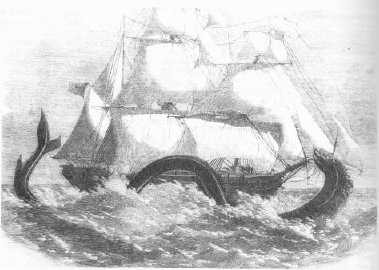
Image of a sea serpent that allegedly attacked a sailing vessel, the British Banner, on April 25, 1859. The creature in this image matches the description of the Gloucester sea serpent, including the horn on the creature's head.
|
|
The Gloucester Sea Serpent On August 10, 1817 a strange creature was sighted in the harbor of Gloucester, Massachusetts. Reports of it began to spread throughout New England. |
 Image of a sea serpent that allegedly attacked a sailing vessel, the British Banner, on April 25, 1859. The creature in this image matches the description of the Gloucester sea serpent, including the horn on the creature's head. |
General David Humphreys, a former member of George Washington's staff, travelled down to Gloucester to interview witnesses. According to the testimony he gathered, the creature's head, which it held above the water, was "much like the head of a turtle... and larger than the head on any dog." From its head there rose "a prong or spear about twelve inches in height, and six inches in circumference at the bottom, and running to a small point." In a compilation of sightings printed in the Boston Weekly Messenger it was further reported that the creature was sixty to seventy feet in length, that it was about as wide as a barrel, that it moved rapidly in a serpentine fashion, that it was able to double back upon itself instantaneously, that it was "full of joints and resemble[d] a string of buoys on a net," and that all attempts to kill or capture it, including shooting a musket at it from close range, failed. |
|
On August 18, 1817 the Linnaean Society of New England appointed a special committee to "collect evidence with regard to the existence and appearance of any such animal." This committee soon thereafter published a pamphlet in which it announced that the sightings of the creature represented the discovery of an entirely new genus, the Scoliophis Atlanticus. However, the society's pamphlet met with ridicule, and inspired the production of numerous fake accounts of the creature. The account was particularly ridiculed in the South, where it inspired the Charleston playwright, William Crafts, to compose a play titled The Sea Serpent; or, Gloucester Hoax: a Dramatic jeu d'esprit in Three Acts. The premise of this play was that the serpent was a hoax, designed to promote the reputation of the town of Gloucester. Others, however, took the reports of the creature seriously. Jacob Bigelow composed an essay about the creature for Benjamin Silliman's prestigious American Journal of Science, and Arts. Interest in sea serpents reached an even greater pitch in America when there were mass sightings of a serpent off the coast of Nahant in 1819. References:
|